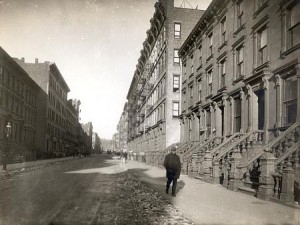R.I.P. (Rise in Power) Black Harlem!
On Tuesday, the New York Times published a story entitled “As Population Shifts in Harlem, Blacks Lose Their Majority.” The article started a firestorm of commentary on listservs and in my twitter feed so I thought I’d throw a couple of things out there. Many are treating this article as if it’s a formal obituary reading R.I.P. Black Harlem. Before we inscribe Rest In Peace, what if it meant Rise in Power Black Harlem? Not following me yet, I think the article missed at least 5 key things.
1) Captain Obvious to the rescue
If you have walked around Harlem in the last ten years, this story should not or does not surprise you. Everyone I passed the link or story around to who has lived here for a while responded with amusement, confirmation, and continuing with their day. Why? In part because demographic shifts get picked up by the census after people experience it in their everyday lives. The standard “quick and dirty” test of racial segregation within NYC that I give my students is the “train test.” I ask them, “Where do you get on? Where do you get off? What type of people (ethnicity) get off at your stop? When can you get a seat?” These questions lead them to think about demographic change in terms of race, ethnicity, economy, and space. In short, ride a train and you’d know that non-“Black” folks have been streaming uptown for a while now.
2) The Great White Fear
The article features a lovely picture of a White man, Joshua Buachner and his 2 year old daughter. It’s amazing how a docile picture of brownstone can create such a panic. The responses I saw highlighted the booming White surge in Harlem. Well kids, look at the numbers! First, the article plainly states Central Harlem has received a boom, doubling so now that means 1 in 10 residents in Central Harlem are White! Whoa! One in 10 … yeah, that’s right let it marinate … oh wait, not running scared? Right! The percentage of White residents was so low that a doubling lead to 1 in 10. If you look at the graphs provided, you’ll see there is a significant uptick but not one many are concentrating on. And trust me, 1 in 10 shouldn’t make you think when you get of at 125th that you got off in the Upper East Side. Perspective is everything.
3) Urban Amnesia
The article pretty much steps over the entire history of redlining and other forms of systematic depreciation of Harlem properties and shuffling of the Black population into Harlem. Redlining served to keep people from buying property, served to make folks who had property sell instead of “riding the tide”, served to limit commerce in Harlem, and even carried a premium for services used by residents. Yes, there was significant outmigration, but this outmigration operated in concert with the “invisible hand” of financial incentives for some and disincentives for others. In reality, Black Harlem has really been leased space. A significant number of Black folks were able to buy, but many if not most Black folks in Harlem did not own; they rented. The result is that the owners left, the renters stayed, and Harlem’s economic depression continued for far too long. The out-migration and in-migration (depends on who you ask also known as gentrification) is not happenstance. Yes, everyone has individual agency and choices, but one’s choices are shaped by larger forces.
4) Black is, Black ain’t?
The article stresses the decrease in “Black” families, which the author never defines but we can take to mean largely African-American families. In passing the article mentions the increasing numbers of Black residents who are not African-American such as West Indian and Continental African immigrants. This expansion of the African diasporic presence can be seen in food choices, neighborhood institutions, and has undoubtedly added to the flavor of Harlem… but what about the “other” folks? You know, the ones the article gives short sell to? The most rapidly increasing groups in Harlem according to the chart are the “other(s).” And I’d bet, though I don’t have the data, this is an increase in Latinos, particularly Afro-Latinos. The article quickly mentions that the Latino population is at an all time high in Central Harlem and Harlem at large. It seems that that for the past 30 plus years, Latinos have been moving in and occupying neighborhoods throughout Harlem without large alarm and cover stories. Uptown has a bustling Afro-Latino population which should not continue to be overlooked. If you are a student of Harlem, you know there has been tension but also very fertile ground around race and ethnic solidarity between African-Americans, Continental Africans, Puerto Ricans, Dominicans, etc. This could represent a greater Pan African possibility … or panic, it’s up to us to decide.
5) Whose/Who’s Harlem?
The next steps for Harlem are in motion. Yes, there is an increasing White presence, but to me the more important part is that there is an increasing Latino presence, particularly Afro-Latino population. These are the moments when Harlem residents have a chance to redefine what it means to be Black Harlem. While in the 20th century Harlem witnessed the extreme flight of Whites and its Blackening, the process does not have to be reversed. Everyday when I walk around Harlem and the Heights I see the beauty of the Diaspora. A key to maintaining our stake and status in this historic “capital of Black America” is looking for links of solidarity around affordable housing, living wages, and community. Black Harlem has always been what its residents made it out to be. Ownership has never been the bedrock of the community, instead its vibrance of our people creating beauty in the midst of struggle.
Filed under: Boundaries, Class, Economics, Food for Thought, General, Harlem, New York City, The Train




Pingback: Tweets that mention R.I.P. (Rise in Power) Black Harlem! - Uptown Notes -- Topsy.com()
Pingback: uberVU - social comments()
Pingback: All About Family()
Pingback: We Must Save Black Bookstores - Uptown Notes()
Pingback: We Must Save Black Bookstores | My Black Networks® -The Latest News from The African Diaspora()